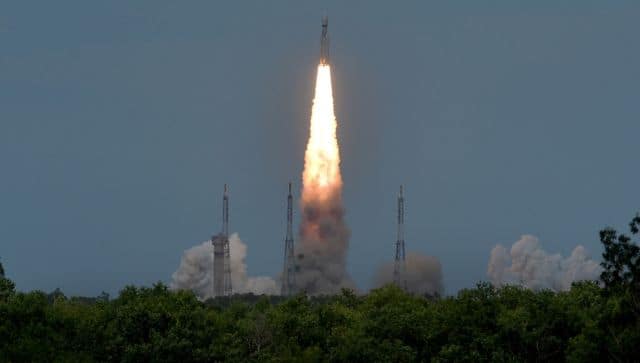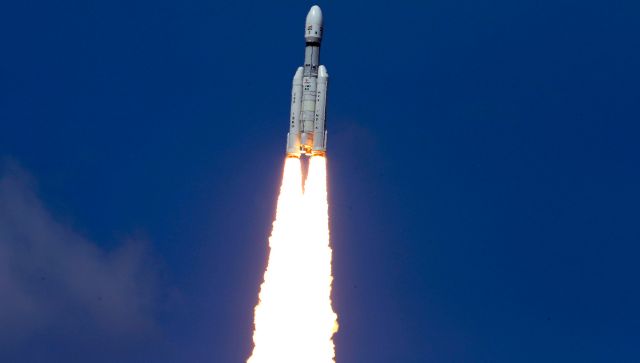India’s third lunar exploration mission, Chandrayaan-3, successfully completed the critical trans-lunar injection (TLI) on early Tuesday (1 August) and has now started its journey towards Moon. “Chandrayaan-3 has completed its orbits around the Earth and is heading towards the moon. A successful perigee-firing performed at ISTRAC (ISRO Telemetry, Tracking and Command Network),” PTI quoted Indian Space Research Organisation (ISRO) as saying. According to reports, the TLI was scheduled for 1 August between 12 midnight and 1 am. What happens next? When will Chandrayaan-3 spacecraft land on the lunar surface? Let’s understand. Chandrayaan-3 mission ISRO launched Chandrayaan-3 from the Sathish Dhawan Space Centre in Andhra Pradesh’s Sriharikota on 14 July, with
Launch Vehicle Mark-III (LVM3)
lifting off the spacecraft into Geo Transfer Orbit (GTO). The spacecraft consists of a two-metre tall robotic moon lander – Vikram – and rover Pragyaan. Since its launch, the mission completed five Earth-bound maneuvers (EBMs). While one was to raise the altitude at the nearest point from the Earth or perigee, the other four were to increase the altitude from the farthest point or apogee noted Times of India (TOI). The first EBM carried out on 15 July catapulted the spacecraft into a 41,762 km x 173 km orbit, while the last EBM by ISRO achieved a 1,27,609 km x 236 km orbit. [caption id=“attachment_12943592” align=“alignnone” width=“640”] After completing its orbits around the Earth, Chandrayaan-3 is now heading towards the Moon. Reuters File Photo[/caption] After revolving around Earth for more than two weeks and finishing five orbit-raising moves, Chandrayaan-3 began its five-day journey to Moon on 1 August. An ISRO official confirmed to the news agency PTI that the spacecraft left the Earth’s orbit after the TLI manoeuvre, which placed it on the ’lunar transfer trajectory’. As per News18, TLI is performed by a chemical rocket engine, involving a powerful burn. This burn enhances the speed of the spacecraft propelling it into the Moon’s sphere of influence. What’s next? The mission is currently in a transfer trajectory phase that will last five days before its advance to the lunar phase. The 2145-kg propulsion module, carrying atop the landing module – Vikram and Pragyan – will travel in a straight path to reach the lunar orbit, as per TOI.
After completing its orbits around the Earth, Chandrayaan-3 is now heading towards the Moon. Reuters File Photo[/caption] After revolving around Earth for more than two weeks and finishing five orbit-raising moves, Chandrayaan-3 began its five-day journey to Moon on 1 August. An ISRO official confirmed to the news agency PTI that the spacecraft left the Earth’s orbit after the TLI manoeuvre, which placed it on the ’lunar transfer trajectory’. As per News18, TLI is performed by a chemical rocket engine, involving a powerful burn. This burn enhances the speed of the spacecraft propelling it into the Moon’s sphere of influence. What’s next? The mission is currently in a transfer trajectory phase that will last five days before its advance to the lunar phase. The 2145-kg propulsion module, carrying atop the landing module – Vikram and Pragyan – will travel in a straight path to reach the lunar orbit, as per TOI.
Chandrayaan-3 is likely to reach the lunar orbit on 5 August.
“Next stop: the moon. As it arrives at the moon, the Lunar-Orbit Insertion (LOI) is planned for 5 August 2023,” India’s space agency said.
Once the propulsion module reaches the initial lunar orbit on 5 August, it will slowly descend into a lower and lower orbit, taking the lander and rover from the injection orbit to a 100-km circular lunar orbit. According to TOI, ISRO is expected to perform at least four Moon-bound manoeuvres to reach its desired circular orbit. However, this is yet to be officially confirmed by the space agency. With the Lunar-Orbit Injection, the moon-centric phase has begun. As per ISRO, this phase includes the Moon-bound manoeuvre phase, propulsion module and lunar module separation, de-boost phase and pre-landing phase. The mission will then progress to the landing phase. According to The Hindu, the separation of the lander module from the propulsion module could take place on 17 August. ALSO READ: Chandrayaan-3’s launch successful: Meet the team behind India’s Moon mission When will Chandrayaan-3 land on Moon? The ISRO has previously said it would attempt a soft landing of the spacecraft on the lunar surface on 23 August. However, as per Hindustan Times (HT), the timing may change depending on the Moon’s sunrise. The space agency may then shift the landing to September. The objectives of India’s third lunar mission are almost similar to that of the previously unsuccessful Chandrayaan-2. It aims for the lander module to have a safe and soft landing on the south pole region of the Moon. After the soft landing, the rover will examine the surface of the Moon through its payload APXS - Alpha Particle X-Ray Spectrometer. Its other payload – Laser-Induced Breakdown Spectroscope (LIBS) – will try to analyse the elemental composition of soil and rocks around the lunar landing site, as per Economic Times (ET). ISRO also intends to carry out scientific experiments on the lunar surface. With inputs from agencies
)